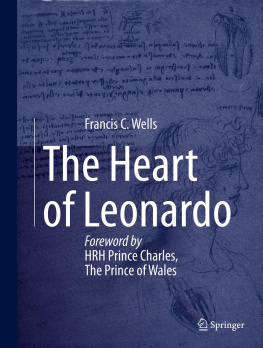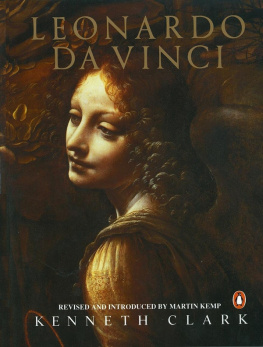Francis C. Wells The Heart of Leonardo 2013 Foreword by HRH Prince Charles, The Prince of Wales 10.1007/978-1-4471-4531-8_1 Springer-Verlag London 2013
1. The Making of a Master: Leonardo, His Life and Times
Late one evening, in the springtime of 1452, in the low foothills of Montalbano, northwestern Tuscany, an illegitimate baby boy was born to a local farmers daughter called Caterina. The child was Leonardo da Vinci. He was conceived, perhaps, as the result of a brief romantic entanglement between the relatively affluent son of an old Vinci family of notaries (Ser Piero da Vinci) and a woman of lower birth, about whom very little is really known. He would grow into the original Renaissance man, whose good looks, charm, and charisma became a legend in his own time. Furthermore and pertinent to our story, he would become a contemporary icon for both science and the arts.
Although very little is known about his early life, we do have the exact date and time of his birth. A German research worker, Dr. Emile Mller, discovered it in the state archives in Florence in the 1930s. Mller discovered the details of the birth on the back of an old notary protocol book. Leonardos grandfather, Ser Antonio da Vinci, had recorded them there, along with the births and baptisms of his own four children. The notebook was clearly of some significance to the family, as Leonardos great-grandfather, Ser Piero di Guido da Vinci, had previously owned it. He wrote: There was born to me a grandson, the son of Ser Piero my son, on the 15th day of April, a Saturday, at the third hour of the night (10:30 p.m.). He bears the name Lionardo; he was baptized with the name Lionardo by the priest Piero di Bartolomeo da Vinci.
The baptism of Leonardo in front of the family and ten witnesses suggests that despite his illegitimacy there was no attempt to conceal his arrival. Antonios note continues with the names of those witnesses. The parish priest in Vinci was Piero di Bartolomeo, a near neighbour of the da Vinci family home. Therefore, although the birth may have been in Anchiano, it is likely that the baptism took place in Santa Croce, the Vinci parish church. The font around which this event probably took place can still be seen, and is celebrated by a stone plaque on the wall of the small baptistery.
The Anchiano house stands on a promontory overlooking the Arno valley, with a view that finds reprise in Leonardos first known drawing (Fig. It is known that Leonardos grandfather was involved in the sale of that house, as he is recorded as being called upon to draw up the sale contract in October of 1499.
Fig. 1.1
The house in Anchiano thought to be Leonardos first home
At that time, illegitimacy bestowed some penalties in education and potential social position, with limitations on access to some professions. For Leonardo, these limitations seem to have affected the breadth of his education, as later in life he records his struggle to learn Latin and Greek, but it seems that his illegitimacy did not stand in the way of a constructive childhood. It is very likely that his birth into a family of notaries and lawyers meant that he was nurtured in an environment of some scholastic significance; his beautifully neat handwriting with notarial flourishes attests to a significant degree of guidance and support in the basics of his education. Vasari reported that he was gifted in his abilities in mathematics, and his skills in geometry were certainly honed later through his association with Luca Pacioli. He was very well aware of the classics in his later years, as his own catalogue of his library attests. He is described as being a competent musician, performing with the lyre to a standard that brought him an appreciative audience.
The extent of the influence of his father in all of this is impossible to know. There is significant evidence to prove that Ser Piero no longer resided in Vinci at that time. Records show that in 1450, following a brief period in Pisa, he had already taken up a post as a notary in Florence. Therefore by that time Piero must have been a visitor to his home, perhaps drawn back by a beautiful girl with whom there could actually be no future. No more than 18 months after Leonardos birth, Piero married Albiera degli Amadori, the daughter of a wealthy Florentine notary. Being of higher birth, Albiera would have been much more in keeping with his intended station in life. It is important to note that following Leonardo, Ser Piero had no children by Albiera, who died in childbirth, and no further children until Leonardo was 20 years old.
It would appear that Leonardo grew up with his grandparents as guardians. In his 1457 tax return, Leonardos grandfather, Antonio, listed the 5-year-old Leonardo as being part of his household. His grandmother Lucia and his young uncle Francesco, with whom he had a lifelong relationship, were all together at that time. It is likely that Leonardo later spent a significant amount of time with his father in Florence, especially when apprenticed to the studio of Master Andrea del Verrocchio.
Meanwhile, his uncle Francesco remained childless and worked locally on the family properties around Vinci. Francesco owned a mill, and he and his brother Piero had rebuilt and managed a local kiln at the convent of San Pier Martire. His paternal grandmother had come from a family famous for their majolica pottery. Hence, Leonardo would have been exposed to artisan activities as well as being surrounded by olive groves and vineyards that are not much changed to the present day. As Leonardos uncle Francesco was closer in age to Leonardo than his brother Ser Piero, it is probable that he would have been a companion for Leonardo, as well as a substitute parent.
Leonardos father, Ser Piero, went on to have 4 wives and 11 legitimate children. It was perhaps fortunate for Leonardos emotional development that these stepsiblings all arrived after he had reached manhood and independence. When his father died, he left nothing to Leonardo, his first-born son. Yet when Francesco died, he left his entire estate to Leonardo. The result was a bitter feud between Leonardo and his stepsiblings.
One of the few facts known about Leonardos mother is that shortly after Leonardo was born, she married a local man, Antonio Buti, nicknamed Acattabrigha (the brawler). In local tax returns, Caterina is recorded as living with her family in Campo Zepo, close to Vinci. Caterina produced six children during the next 11 years, five girls and one boy. Her only legitimate son, Francesco, was killed by a shot from a military catapult.
Wherever Leonardo laid his head at night in those most formative of years, it seems clear that the family arrangements for the young Leonardo were not simple, and he must have experienced emotional tensions from many directions. Caterinas growing family needed a lot of her attention, and Ser Pieros busy life with a new wife in Florence kept them apart, Leonardos emotional and intellectual centre of gravity was probably with his grandfather, grandmother, and uncle. In his later notes, Leonardo refers to the funeral of a Caterina in an unemotional way.














